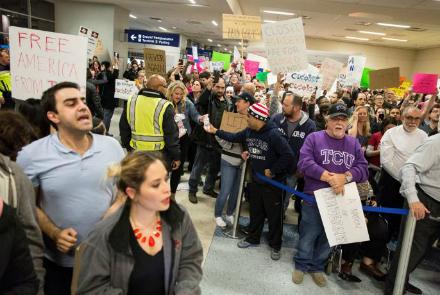On Friday U.S President Donald Trump signed an executive order banning entry from seven majority-Muslim countries – Iran, Iraq, Libya, Somalia, Sudan, Syria and Yemen – for 90 days and shutting down the entire immigration program for 120 days.
Afghanistan has not been listed among the seven countries but reports indicate Afghan immigrants are also being detained at U.S airports.
Despite the order being vague, The Guardian has mapped out what the order means.
- Suspends the entire US refugee admissions system for 120 days, even though it was already one of the most rigorous vetting regimens in the world, taking 18 to 24 months and requiring interviews and background checks through multiple federal agencies. Trump has said he wants more strictures – but did not described them.
- Suspends the Syrian refugee program indefinitely. The US accepted 12,486 Syrian refugees in 2016, compared with about 300,000 received by Germany the same year. Since the Syrian civil war began, Turkey has received about 2.7 million refugees, Lebanon 1 million refugees and Jordan 650,000.
- Bans entry from seven majority-Muslim countries – Iran, Iraq, Libya, Somalia, Sudan, Syria and Yemen – for 90 days. Possibly the vaguest of Trump’s orders, in practice this has barred even legal U.S residents, such as green card holders, from re-entry into the country. The order would let the Department of Homeland Security ban more countries at any time.
- Dual-nationals who are from those seven countries but have an additional passport will also be barred from entering the country for the next 90 days, according to the State Department. This means that citizens of Iran, Iraq, Libya, Somalia, Sudan, Syria and Yemen who have a passport from another country, such as Britain or France, are also subject to the ban.
- It remains unclear how the US will determine if somebody is in fact a dual- national. “There is no clarity on how they’re going to interpret this,” said Abed Awad, an attorney and member of the national board of the American-Arab Anti-Discrimination Committee. Awad explained that while a person may not hold a passport from that country, if they were born there or have parents from there, they may be considered a citizen or eligible for citizenship, despite in some cases never having visited that country. It remains unclear if the U.S will consider those people dual-nationals.
- Prioritizes refugee claims on the basis of religious persecution, so long as the applicant belongs to a religion that is a minority in their country of origin. This provision would allow the Trump White House to prioritize Christians from the Middle East over Muslims. In fiscal year 2016, the U.S accepted 37,521 Christian and 38,901 Muslim refugees. Since 2001, the U.S has accepted nearly 400,000 Christian refugees and 279,000 Muslim refugees.
- Lowered the total of 2017 refugees from anywhere to 50,000, down from 110,000. It has also ordered a review of states’ rights to accept or deny refugees; last year Mike Pence, then governor of Indiana, was slapped down by an appeals court when he tried to stop the resettlement of Syrian refugees in his state.
What are the immediate consequences?
Confusion and despair at ports and airports as approved refugees, valid visa holders, non-U.S dual citizens and U.S legal residents are detained, barred from planes or ordered out of the U.S, while attorneys and authorities grapple.
Immigration lawyers and employers have warned many people not to leave the U.S for fear they could be barred from re-entering.
Nearly 500,000 people from the seven nations have received green cards in the past decade, meaning hundreds of thousands of people are at risk of being barred from the U.S or separated from their families.
Universities, hospitals and tech companies reeled from the order, which threatens or has already banned thousands of doctors, students, researchers, engineers and others.
Nearly 200 Google employees, for instance, are affected, prompting the company to recall them to the U.S in coordination with lawyers. The orders will almost certainly affect how companies hire employees and commit to trade deals.
So far, the vagueness of the orders appears to leave great authority in the hands of local law enforcement at ports and borders, creating chaos and arbitrary detentions and questionings. For months, immigration lawyers warned that trying to implement a ban would create a swamp of bureaucracy, lawsuits and possible civil rights violations.
What are the legal challenges to the ban?
Opponents of the order have indicated they will challenge it on at least two fronts: that it sets an unconstitutional religious test, in violation of the first amendment’s freedom of religion; and that it violates the fifth amendment’s right to due process. Plaintiffs will argue that they have committed no offense, nor even been charged with one, before being targeted.
But the supreme court has historically deferred to Congress and the White House on immigration enforcement, granting wide powers to the president over the nation’s borders.
The court has reserved its right to review cases though, and never directly confronted an immigration case with religious preference as a central premise – it has examined cases involving race and political beliefs. Last year a supreme court case over Barack Obama’s immigration authority ended with a deadlock (4-4) that sent the issue back to a lower court and froze his attempt to protect some undocumented people.

